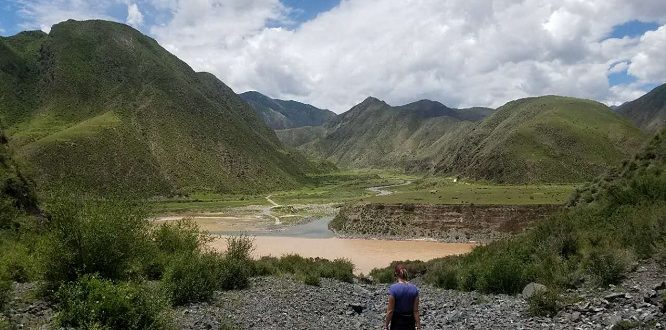A Transformation in Tibet
Tess McEnroe a photographer, digital film teacher and river guide took an exploration through Tibet last summer to explore, teach and learn more about the complex waterways in the area. What she found can only be described as a true passion for the river and a look into understanding the way they work and how they should be preserved. Follow along as she takes her Watershed Drybags into the mountains of Tibet!
Reflecting on Wilderness Exploration and Feminism
On a rainy morning in late August of 2017, I sat on the banks of a river, drinking my coffee just as I have so many other times in my life. As always at that point in a full commercial river season, my body was tired and long overdue for a shower. My brain was worn out, and I was ready to have someone cook for me. Yet also as always, the world can surprise you with a moment of clarity and rejuvenation. All it took for me that day was a young boy, a bulldozer and a juniper tree.
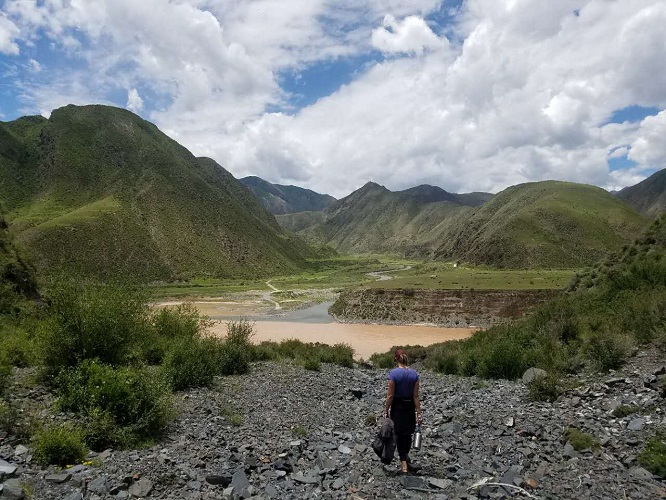
Our trip gathered on the beach and listened to the last daily talk on the river for the season. We had just spent 10 days together on the Mekong, or Daqu, River high on the Tibetan Plateau in Western China. Peter, a precocious nine-year-old and our designated Chinese “yoda” of the group, was speaking about the local plants and their special characteristics. At the exact same moment that Peter was explaining the medicinal and healing properties of the juniper tree and its sacred meaning to the Tibetan culture, the relentless growl of a bulldozer clearcutting could be heard and seen directly across the river from us. As we watched it rip out multiple juniper trees to widen the road, Peter kept speaking, determined not to be overpowered by the destruction, and was still translated through three languages so that everyone could understand. I cried behind my sunglasses. We all cried – tears and smiles speak the same language. We cried for the future. We cried for the river we had fallen in love with. I’m confident to say at that moment every single one of us on that beach – Americans, Tibetans and Chinese – wanted to fight “the man” and save the world together.
After 13 years of running rivers, I’ve tried to articulate the reason and feelings of what keeps me coming back. Not just to rivers, but whatever community we as adventurers love and are addicted to – climbing mountains, surfing waves, skiing powder or anything else that brings us joy with our people. We chase never ending seasons, and often live nomadically. We push ourselves physically – and most important, mentally. Finally, after lots of miles and many years of this chosen lifestyle, I think I’ve found my own answer to that question: I keep coming back to the river for clarity and rejuvenation.
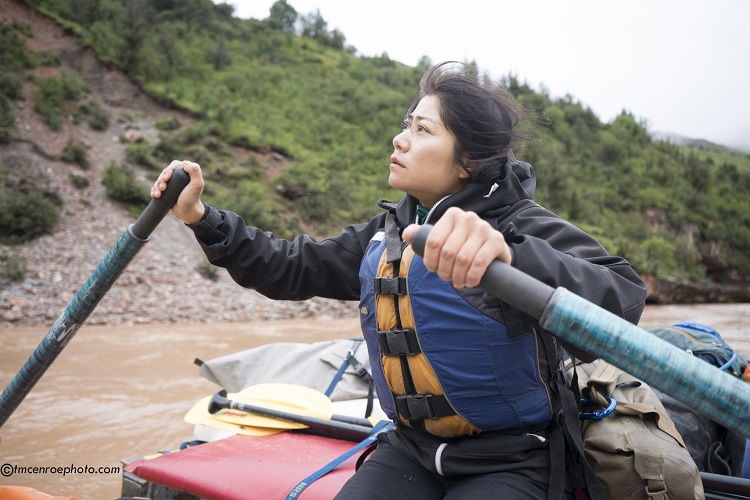
Last Descents River Expeditions
I had always wanted to work internationally and in the spring of 2017, my friend Kiki gave me a phone call asking if I wanted to run a few river trips and work in China for a company called Last Descents River Expeditions. I said yes without hesitation, having heard wonderful things from mutual friends who guided for them. We had many laughs, a few challenges, but overall an incredible experience. We brought each other morning coffee to our tents, chopped hundreds of vegetables in the rain, and ran some of the most difficult, but amazing trips of our river running careers. We are women who are excited to explore the world, and push ourselves. We truly had a grand adventure in Tibet.
On my second day at our crew base in Yushu, China, Kiki and I started to plan our own exploratory trip since we had five days before we officially began working. We decided to run a section of the Upper Yangtze, the longest river in China and the third longest river in the world. Last Descents is one of the only river companies in China, and is dedicated to preservation of the rivers. Travis Winn, the American owner, says he named the company “Last Descents” not as an ominous title, but a way of telling the world that, “we need to explore, paddle and protect these rivers before they are all under water from dams and development.” Travis has dedicated a majority of his life to running and protecting rivers in China, and has many of the first descents in the country.
Now, we were about to travel deep into the Tibetan backcountry, and paddle one of the biggest, most turbulent rivers in Asia, yet alone the world. We barely had a map and had no idea how many kilometers we would ultimately travel. There is no other feeling to me like running a new river. Venturing into the unknown downstream fills me with excitement, nervousness and curiosity.
Running the Yangtze River
We packed tightly into our smallest dry bags, doing a backpacking-style four-day river trip in an ancient and foreign landscape. Travis arranged the driver, gave us a satellite phone, wished us well and sent us off. Four rainy hours later, and a few wrong turns, our Tibetan shuttle driver and 4×4 minivan descended the final dirt road as we dropped into the emerald green valley of the Upper Yangtze River, near its headwaters flowing off of the the Himalayan plateau. He turned out to be our favorite driver, and looked extremely hesitant to leave us out there.
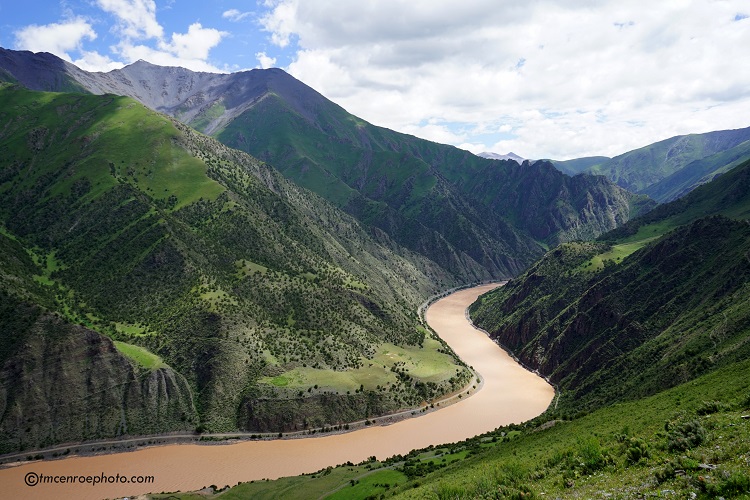
As we pushed off from shore in our little, yellow, 10-foot raft we affectionately dubbed “the tater tot,” Kiki and I smiled, looked at each other with a glimmer of excitement and “holy shit, we are really doing this” in our eyes. I had never done a one-boat, two-person, self-supported river trip, let alone one at 14,000 feet. My heart was racing, partly from elevation, but more from pure adrenaline. We decided to tether ourselves to the raft just in case we flipped or swam – a reality we dreaded. This was a bold decision, as it is extremely dangerous to have lines in moving water. But we decided it was safer than potentially getting separated from our boat, by the unforgiving, swirling currents of the Yangtze.
Part of the reason for this trip was to report back to Travis and our crew on the development and construction along that section of river. We documented roadwork that was creating new rapids, bridges under construction and the overall “health” of the watershed. As an emerging, world-dominant country that is proposing hundreds of dams on its rivers in the name of money and power, China measures its rivers’ health in hydropower, not water levels or wildlife. This natural landscape is on the brink of either complete destruction or environmental rescue. In 2015, the Chinese government began to set up a plan to create a nature reserve and national park system in the Sanjiangyuan (meaning “three rivers”) region of the Qinghai-Tibetan plateau. These rivers include the Yangtze, Yellow and Mekong Rivers. This area on the eastern edge of the Himalayas, is known for its high altitude, arid ecosystem, and is a landscape vulnerable to climate change.
Two of the First
We humbly believe, along with our crew at Last Descents, that we were the first two women to descend that stretch of river alone. But that doesn’t matter as much as the sense of adventure we felt – hiking steep ridgelines, waving to local villagers, floating by the hand-carved mani stones and temples, and seeing a Tibetan wolf on our last morning. Four days later, we emerged triumphant with an immense sense of gratitude for this landscape buzzing with energy.
This experience planted new questions in my head: What is the relationship between modern life and cultures that still live, rooted in the knowledge of millennia? How do we define wilderness and conservation in a place where both of those ideas are fairly new?
Rivers connect us; they’re the pulsing, freshwater veins of planet Earth. You could argue that almost any remote place on Earth is unique, but I argue that the Tibetan Plateau is uniquely unique. Nomads have roamed the hillsides for thousands of years, herding their beloved yaks, using every yak body part for human survival. Today, there is a mixture of the new world and old. Wall tents stand next to cell phone towers. But still, prayer wheels keep spinning, yak dung fires keep burning and mani stones are still being carved. This is a place where we saw snow leopard tracks in the sand at our camps – one of the few places in the world these animals can be seen in the wild.
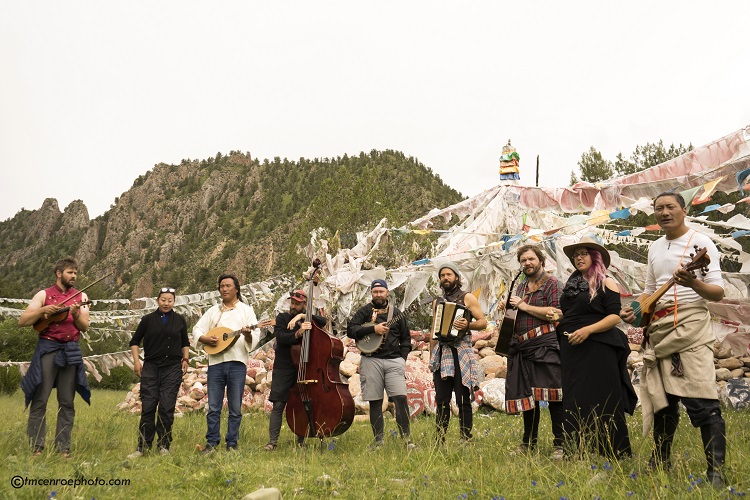
We spent the rest of our time running commercial trips on the Daqu River. The first was a music trip comprised of an American bluegrass band from Nashville and local Tibetan folk singers, along with Chinese children learning to kayak (Peter) and their parents. We floated into a music festival (which was nuts!), had lessons along the riverside and impromptu jam sessions at camp.
The second was a government officials’ trip to educate local officials to protect the river system and designate it as the first National Park in China to include a watershed: an awesome goal, but also really challenging. These trips truly changed my perspective on the livelihood of running rivers. I’ve always known guiding is bigger than merely taking people downstream, but this experience made me believe all over again that you can try to save the world in many different ways.
Women and the Watershed
I also came away from China with a different appreciation for women who adventure. As an American woman who has long been employed by outfitters where women are treated equally, but also have dealt with discrimination in my field, working these trips in China changed my view of “adventure feminism.” I am lucky enough to guide alongside many incredible women, as we continue to push ourselves and the gender boundaries of sports and jobs. Women in China are beginning to explore their landscape and learn skills to work in the wilderness. Running these trips in China with women who were learning to guide and run their own rivers was quite empowering. Just as in so many other professions, it has taken women longer to approach equality as river guides – or any kind of wilderness guide – both in numbers and responsibility. It really wasn’t until the 1950s and 60s that women slowly broke into the world of wilderness exploration and, even then, those who succeeded were few and far between. Even today, I’m asked by men if they can carry that heavy box for me, or if I’m sure I want to run that big rapid.
I truly believe women are coming to a watershed moment for equality, and are uniting internationally together for change. Time is up, no more bullshit.
_____
Over the years, I’ve met many women who paved the way for others to work in the backcountry, and I bow down to everyone who has raised hell to break the glass ceiling. My time in Tibet helped me evoke a new dimension of personal transformation. Many years and river miles later, I am grateful to now know the “why,” — why I’ve always chosen the river, and why I continue to for the clarity and rejuvenation I seek.
Simply, it is because I can.
I believe I can help make the world better by sharing my love of rivers and wild places. I can help educate people about the threats facing a watershed. I can use this shared journey to teach people why we must save our fierce yet fragile landscapes, and the ancient cultures who call them home. I can and will push the boundaries of gender roles, and can do it self-sufficiently. I can help conserve and define what wilderness means to the world — a world today that needs us more than ever to fight for it. I can do all of this as a strong, independent person, and I too will keep going despite the bulldozers in life.
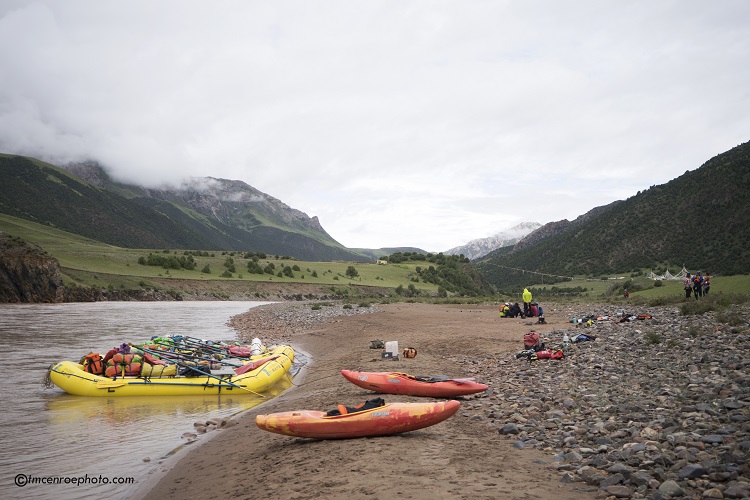
The river is my longest relationship, my greatest love affair and, single-handedly, she has changed and shaped my life for the better. She has pushed me, watched me grow up, fall in love and healed my heartbreak. The river is my boulder and my butterfly – a constant, grounding source I go back to, that is also, no matter how many times you run it, always in motion and never the same. Just as a stone, she smoothes my sharp edges while allowing me to keep evolving wild and freely.
________________________________________________________________________________________________________________________
Watershed Drybags is a proud supporter of many diverse programs including helping youth find their true passion on the water and conservation in the United States and beyond.
Where will you take your Watershed Drybag?

